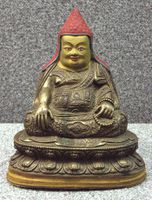Dol po pa: Difference between revisions
No edit summary |
No edit summary |
||
| Line 28: | Line 28: | ||
|BnwShortPersonBio=Dölpopa Sherab Gyaltsen was one of the most influential Buddhist masters in Tibetan history. He first became an important scholar of the Sakya tradition, but then moved to Jonang Monastery. There he became the fourth holder of the monastic seat and constructed a monumental stupa. Dölpopa’s ideas, specifically his famous formulation of the zhentong view and his interpretations of Mahāyāna and Vajrayāna doctrine, have elicited controversy for nearly seven hundred years. | |BnwShortPersonBio=Dölpopa Sherab Gyaltsen was one of the most influential Buddhist masters in Tibetan history. He first became an important scholar of the Sakya tradition, but then moved to Jonang Monastery. There he became the fourth holder of the monastic seat and constructed a monumental stupa. Dölpopa’s ideas, specifically his famous formulation of the zhentong view and his interpretations of Mahāyāna and Vajrayāna doctrine, have elicited controversy for nearly seven hundred years. | ||
|PosBuNayDefProv=Definitive | |PosBuNayDefProv=Definitive | ||
|PosBuNayDefProvNotes= | |PosBuNayDefProvNotes="For Dölpopa, the teaching on buddha nature is of definitive meaning and serves as one of the cornerstones of his Shentong view. He typically describes both buddha nature and the dharmakāya as being ultimately really established, everlasting, eternal, permanent, immutable (ther zug), and being beyond dependent origination." [[Brunnhölzl, K.]], ''[[When the Clouds Part]]'', p. 68. | ||
|PosAllBuddha=Yes | |PosAllBuddha=Yes | ||
|PosAllBuddhaMoreNotes="The crucial stanza [RGV] I.27, in which the three reasons for the presence of a buddha nature in sentient beings are presented, is thus explained in the following way: | |PosAllBuddhaMoreNotes="The crucial stanza [RGV] I.27, in which the three reasons for the presence of a buddha nature in sentient beings are presented, is thus explained in the following way: | ||
Revision as of 12:20, 29 September 2020
| PersonType | Category:Classical Tibetan Authors |
|---|---|
| MainNamePhon | Dölpopa Sherab Gyaltsen |
| MainNameTib | དོལ་པོ་པ་ཤེས་རབ་རྒྱལ་མཚན་ |
| MainNameWylie | dol po pa shes rab rgyal mtshan |
| AltNamesTib | ཤེས་རབ་རྒྱལ་མཚན་ · ཤེས་རབ་མགོན་ · རྟོན་པ་བཞི་ལྡན་ |
| AltNamesWylie | shes rab rgyal mtshan · shes rab mgon · rton pa bzhi ldan |
| YearBirth | 1292 |
| YearDeath | 1361 |
| BornIn | gtsang stod mnga' ris dol po gru gsum spu mdo |
| TibDateGender | Male |
| TibDateElement | Water |
| TibDateAnimal | Dragon |
| TibDateRabjung | 5 |
| ReligiousAffiliation | Jonang |
| StudentOf | tshul khrims snying po · skyi ston 'jam dbyangs · skyi ston grags pa rgyal mtshan · sa skya slob dpon shes rab bzang po · gzhon nu bzang po · blo gros bstan pa · jo gdan mkhan po bsod nams grags pa · nag 'bum · jo nang chos rje yon gtan rgya mtsho |
| TeacherOf | jo nang lo tsA ba blo gros dpal · g.yag sde paN chen · bsod nams rgyal mtshan · phyogs las rnam rgyal · sa bzang ma ti paN chen blo gros rgyal mtshan · Drikung Lotsāwa Maṇikaśrī · nya dbon kun dga' dpal · kun spangs chos grags dpal bzang |
| BDRC | https://www.tbrc.org/#!rid=P139 |
| Treasury of Lives | https://treasuryoflives.org/biographies/view/Dolpopa-Sherab-Gyeltsen/2670 |
| Himalayan Art Resources | https://www.himalayanart.org/search/set.cfm?setID=1595 |
| IsInGyatsa | No |
| BnwShortPersonBio | Dölpopa Sherab Gyaltsen was one of the most influential Buddhist masters in Tibetan history. He first became an important scholar of the Sakya tradition, but then moved to Jonang Monastery. There he became the fourth holder of the monastic seat and constructed a monumental stupa. Dölpopa’s ideas, specifically his famous formulation of the zhentong view and his interpretations of Mahāyāna and Vajrayāna doctrine, have elicited controversy for nearly seven hundred years. |
| PosBuNayDefProv | Definitive |
| PosBuNayDefProvNotes | "For Dölpopa, the teaching on buddha nature is of definitive meaning and serves as one of the cornerstones of his Shentong view. He typically describes both buddha nature and the dharmakāya as being ultimately really established, everlasting, eternal, permanent, immutable (ther zug), and being beyond dependent origination." Karl Brunnhölzl, When the Clouds Part, p. 68. |
| PosAllBuddha | Yes |
| PosAllBuddhaMoreNotes | "The crucial stanza [RGV] I.27, in which the three reasons for the presence of a buddha nature in sentient beings are presented, is thus explained in the following way:
Since the dharmakāya of the perfect buddha embraces and pervades all phenomena, since there is no differentiation [to be made] within the dharmatā concerning all samsāra and nirvāna, and since the potential of the tathāgata exists in all sentient beings as the natural purity of the dharmadhātu, which can be purified of hindrances, truly every being possesses, always, continuously, and throughout beginningless time, the ultimate essence of the Buddha." Klaus-Dieter Mathes, A Direct Path to the Buddha Within, p. 82. |
| PosWheelTurn | Third Turning |
| PosYogaMadhyaNotes | Dolpopa has a unique view on this issue as Wangchuk points out:
|
| PosZhenRang | Zhentong |
| PosZhenRangNotes | He was not the first to use the term, but he was the one to define and make it a central feature of his innovative philosophical position:
|
| PosEmptyLumin | Tathāgatagarbha as the Emptiness That is an Implicative Negation (with enlightened qualities) |
| PosEmptyLuminNotes | "He typically describes both buddha nature and the dharmakāya as being ultimately really established, everlasting, eternal, permanent, immutable (ther zug), and being beyond dependent origination. He also equates the tathāgata heart with “ālaya-wisdom” as opposed to the ālaya-consciousness." Karl Brunnhölzl, When the Clouds Part, p. 68. |
| Other wikis |
If the page does not yet exist on the remote wiki, you can paste the tag |
